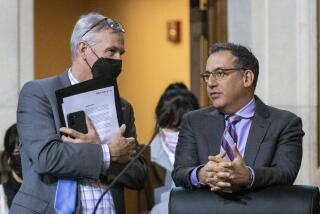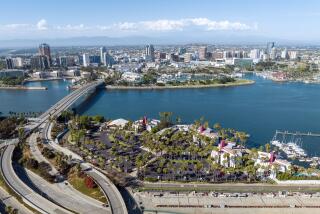Now New Orleans Is Battered by Layoffs
NEW ORLEANS — Underscoring the difficulties facing this devastated city, Mayor C. Ray Nagin announced with “great sadness” Tuesday that New Orleans would have to lay off half of its municipal workforce because of the financial fallout from hurricanes Katrina and Rita.
Nagin said cutting about 3,000 workers would save as much as $8 million of the city’s $20-million monthly payroll. No police officers, firefighters or emergency medical technicians would lose their jobs, Nagin said, but “nonessential” support workers in those departments would be cut.
“We searched high and low,” the mayor said at a somber afternoon news conference. “We just can’t put together the financing to maintain city staff.... I wish I didn’t have to do this.”
With few residents having returned to the city and only a handful of businesses functioning, New Orleans has virtually no tax money coming in to pay employees and maintain operations. The city has received $202 million from the Federal Emergency Management Agency, but federal law allows that money to go only to overtime, not to pay regular salaries and benefits.
Legislators are trying to revise that law, but it will not happen in time to save half of the city workforce’s jobs.
“We would like it to be treated as an emergency matter,” Louisiana Gov. Kathleen Babineaux Blanco said in an interview Tuesday night.
Nagin said he had secured a verbal promise of a $50-million line of credit from a bank; that money, he said, would enable a slimmed-down city to survive about two more months -- and avoid bankruptcy, he hoped.
The mayor also has asked the state to take over payments on New Orleans’ preexisting debts.
“We have no revenue streams, and the prospect of getting any ... is dicey,” Nagin said.
City workers said they were floored by the cuts, and disappointed that the federal government had not found a way to keep New Orleans running.
“If you’re not able to keep the city operating, businesses and people might not come back at all,” said Lt. David M. Benelli, president of the Police Assn. of New Orleans. “That’s a tremendous Catch-22.”
J. Stephen Perry, president of the New Orleans Metropolitan Convention and Visitors Bureau, said most business leaders understood that the mayor had been backed into a corner financially, and believed that he was doing the right thing amid strong political pressure to preserve jobs. Tuesday’s announcement, Perry added, was also a signal to the Bush administration and Congress that the city was not looking for a wasteful handout.
“What he did today was to make a very prudent business decision,” Perry said. “With the tax base decimated for the next six to seven months ... [the city] has lost its basic revenue streams and customer base. You’ve got to pare down to a basic core and rebuild incrementally.”
Perry said he was optimistic that the federal government would come through with an aid package that couldallow New Orleans to meet its streamlined payroll.
Jacquelyn Brechtel Clarkson, a New Orleans city councilwoman who represents 120,000 people in a district that includes the French Quarter and Algiers -- two areas that suffered minimal damage compared with the rest of the city -- blamed the federal government for not coming to the city’s aid.
“We needed help a lot sooner -- and we still need help now,” she said, calling the job cuts the beginning of a “vicious cycle.”
New Orleans is not the only municipality in dire straits. Across southern Louisiana, towns and parishes crippled by the two hurricanes are laying off workers and wondering how they will meet their budgets.
“Mayor Nagin’s announcement is only the first of many, I’m afraid,” said Blanco, who appeared Tuesday at a town hall meeting held by PICO LIFT, a grass-roots interfaith organization. “I do know what these governments are doing. They are spending every nickel, and many are running out of money.”
The New Orleans job cuts have fanned already smoldering resentment toward the federal government here.
“The government needs to realize there’s more to keeping a city alive than just putting up trailer parks,” said Benelli, referring to the FEMA trailers where many evacuees are relocating.
Many of the laid-off workers will need those trailers. “This is horrible,” Nagin said. “A lot of these people lost their homes.”
In fact, the city’s workforce is so scattered that New Orleans will work through FEMA to notify city employees that their final paycheck will be issued next week. Most of those displaced workers are eligible for FEMA benefits to help offset the loss of their homes and jobs.
Almost all city workers reporting for duty -- from police officers on the street to sewage workers repairing lines -- are living outside the city limits, in violation of residency laws that require public employees to hold a New Orleans address.
Nagin said that had led to discussions about scrapping the residency requirement.
Officials did not detail Tuesday who would lose their jobs, but said that the city would continue to employ those critical to cleaning up New Orleans and bringing businesses back. That means sewage and water workers, trash haulers and those who process building and health permits should be largely unaffected.
Nagin emphasized the need to keep emergency workers on the payroll, but did not specify which civilian support jobs would be pared from police, fire and ambulance services. Union officials said that uniformed personnel would have to leave the streets to fill vacant support jobs, such as dispatcher positions.
In response to a question, the mayor said he would not cut his own pay. “I’m homeless, so let’s just put the dagger all the way in,” Nagin said. He has bought a house in Dallas, where his children are attending school. He said the voters could give him “the ultimate cut” during elections in February.
Nagin said he was working with FEMA to move trailers into empty areas of dry neighborhoods, including supermarket parking lots, and that he had proposed enabling residents to park trailers in the driveways of their homes while the houses were being rehabilitated.
Even if Nagin’s plans for repopulating New Orleans go smoothly, he only expects to open neighborhoods that housed fewer than half of the city’s pre-Katrina population. So far, few residents have returned, and the mayor said he would loosen restrictions on reentry to make it easier for people to inspect their homes.
Although the state government called off its search for bodies Monday, local officials are continuing to report new corpses in the hardest-hit parts of New Orleans and the surrounding low-lying areas. The state increased its body count to 972 on Tuesday, and said that number would continue to rise.
Nagin made his layoff announcement Tuesday in front of a banner that displayed the slogan for his effort to revitalize his stricken city: “Bring New Orleans Back.” One questioner asked about the disparity between the slogan and the news.
“When we say ‘Bring New Orleans Back,’ ” the mayor said, “we don’t mean today.”
*
Times staff writer Ellen Barry in Baton Rouge, contributed to this report.
More to Read
Sign up for Essential California
The most important California stories and recommendations in your inbox every morning.
You may occasionally receive promotional content from the Los Angeles Times.











